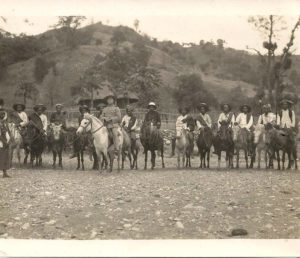At the beginning of the twentieth century, a faltering home economy prompted the Portuguese to extract greater wealth from its colonies, which was met with East Timorese resistance.

Portuguese Timor had been a place of exile for political and social opponents deported from the metropolis since the late nineteenth century. Among them a large proportion were members of the anarchist and anarcho-syndicalist movement, which until the Second World War was the most influential of the left-wing movements in Portugal. The main waves of deportations to Timor were in 1896, 1927, and 1931. Some of the activists continued their resistance even in exile. After World War II, the remaining exiles were pardoned and allowed to return.
During World War II, first the Allies and later the Japanese occupied Dili, and the mountainous interior of the colony became the scene of a guerrilla campaign, known as the Battle of Timor. Waged by East Timorese volunteers and Allied forces against the Japanese, the struggle resulted in the deaths of between 40,000 and 70,000 East Timorese civilians. The Japanese eventually drove the last of the Australian and Allied forces out. However, Portuguese control was reinstated after the Japanese surrender at the end of World War II.
Following the 1974 Portuguese revolution, Portugal effectively abandoned its colony in Timor and civil war between East Timorese political parties broke out in 1975.
The Revolutionary Front for an Independent East Timor (Fretilin) resisted a Timorese Democratic Union (UDT) coup attempt in August 1975, and unilaterally declared independence on 28 November 1975. Fearing a communist state within the Indonesian archipelago, the Indonesian military launched an invasion of East Timor in December 1975. Indonesia declared East Timor its 27th province on 17 July 1976. The UN Security Council opposed the invasion and the territory’s nominal status in the UN remained as “non-self-governing territory under Portuguese administration” .
Indonesian Occupation (1975–1999):
Indonesia’s occupation of East Timor was marked by violence and brutality. A detailed statistical report prepared for the Commission for Reception, Truth and Reconciliation in East Timor cited a minimum of 102,800 conflict-related deaths in the period 1974–1999, namely, approximately 18,600 killings and 84,200 “excess” deaths from hunger and illness, with an estimated figure based on Portuguese, Indonesian and Catholic Church data of approximately 200,000 deaths. The East Timorese guerrilla force (Forças Armadas da Libertação Nacional de Timor-Leste, Falintil) fought a campaign against the Indonesian forces from 1975 to 1998.
The 1991 Dili Massacre was a turning point for the independence cause and an East Timor solidarity movement grew in Portugal, the Philippines, Australia, and other Western countries.
Following the resignation of Indonesian President Suharto, an UN-sponsored agreement between Indonesia and Portugal allowed for an UN-supervised popular referendum in August 1999. A clear vote for independence was met with a punitive campaign of violence by East Timorese pro-integration militia supported by elements of the Indonesian military. This allowed the sending of the multinational peacekeeping force, INTERFET, which was formed by Australia, the Philippines, South Korea, Thailand, and New Zealand, with aid from the United States, to restore order and aid East Timorese refugees and internally-displaced persons. On 25 October 1999, the administration of East Timor was taken over by the UN through the United Nations Transitional Administration in East Timor (UNTAET), headed by Sergio Vieira de Mello. The INTERFET deployment ended in February 2000 with the transfer of military command to the UN.
Contemporary Era:
On 30 August 2001, the East Timorese voted in their first election organized by the UN to elect members of the Constituent Assembly. On 22 March 2002, the Constituent Assembly approved the Constitution. By May 2002, over 205,000 refugees had returned. On 20 May 2002, the Constitution of the Democratic Republic of East Timor came into force and East Timor was recognized as independent by the UN. The Constituent Assembly was renamed the National Parliament and Xanana Gusmão was sworn in as the country’s first President after Indonesian occupation. On 27 September 2002, East Timor was renamed Timor-Leste, using the Portuguese language, and was admitted as a member state by the UN.

